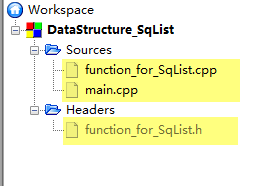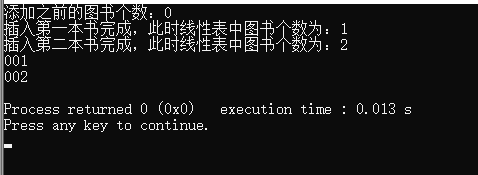项目结构:

main.cpp:
#include <iostream> #include<stdio.h> #include<stdlib.h> #include "function_for_SqList.h" using namespace std; int main() { SqList L; Book book1 = { //创建两本书 "001", "book_one", 23.6 }; Book book2 = { "002", "book_two", 34.7 }; int initResult=0; int insertResult=0; //图书插入结果值返回 initResult = InitList(L); //创建线性表 printf("添加之前的图书个数:%d ", GetLength(L)); //获取当前图书个数 //添加第一本书 insertResult = ListInsert_Sq(L, 1, book1); if(insertResult == 1){ printf("插入第一本书完成,此时线性表中图书个数为:%d ", GetLength(L)); }else{ printf("图书插入失败 "); } insertResult = ListInsert_Sq(L, 2, book2); if(insertResult == 1){ printf("插入第二本书完成,此时线性表中图书个数为:%d ", GetLength(L)); }else{ printf("图书插入失败 "); } for(int j=0; j<L.length; j++){ printf("%s ", L.elem[j].no); } return 0; }
function_for_SqList.h:
//函数结果状态代码 #define TRUE 1 #define FALSE 0 #define OK 1 #define ERROR 0 #define INFEASIBLE -1 //"不可能的" #define OVERFLOW -2//"溢出,扩展出界" //定义常量 #define MAXSIZE 100 //线性表可能达到的最大长度 typedef struct{ char no[20]; //元素ISBN编号 char name[50]; //元素名字 float price; //图书(元素)价格 } Book; typedef struct{ Book *elem; //存储空间基地址 int length; //线性表中当前元素个数 } SqList; //线性表的顺序存储结构类型为SqList typedef int Status; //Status是函数的类型,其值是函数结果状态代码 typedef Book ElemType; //方法 //线性表L初始化(参数用引用) Status InitList(SqList &L); //构造一个空的顺序表 //销毁线性表L void DestroyList(SqList &L); //清空线性表L void ClearList(SqList &L); //求线性表L的长度 int GetLength(SqList L); //判断线性表是否为空 int IsEmpty(SqList L); //获取线性表内容:取第i个元素 int GetElem(SqList L, int i, ElemType &e); //查找:(顺序查找)按值查找(按给定书号进行查找,确定是否存在该图书) /* 如果存在,输出是第几个元素 如果不存在,输出0 */ int LocateElem(SqList L, ElemType e); //插入操作:将元素e插在第i个位置上 Status ListInsert_Sq(SqList &L, int i, ElemType e); //删除操作:删除第i个元素 Status ListDelete_Sq(SqList &L, int i);
function_for_SqList.cpp:
#include<stdio.h> #include<stdlib.h> #include "function_for_SqList.h" //必须加这个头文件include,否则运行时无法识别关键字 //方法 //线性表L初始化(参数用引用) Status InitList(SqList &L){ //构造一个空的顺序表 L.elem = new ElemType[MAXSIZE]; //为顺序表分配空间 if(!L.elem){ exit(OVERFLOW); //存储分配失败 } L.length = 0; //空表长度为0 return OK; } //销毁线性表L void DestroyList(SqList &L){ if(L.elem){ delete L.elem; //释放存储空间(删除此数组) } } //清空线性表L void ClearList(SqList &L){ L.length=0; } //求线性表L的长度 int GetLength(SqList L){ return (L.length); } //判断线性表是否为空 int IsEmpty(SqList L){ if(L.length == 0){ return 1; }else{ return 0; } } //获取线性表内容:取第i个元素 int GetElem(SqList L, int i, ElemType &e){ if(i<1 || i>L.length){//判断i值是否合理,若不合理,返回ERROR return ERROR; } e = L.elem[i-1]; //第(i-1)个单元存储着第i个数据 return OK; } //查找:(顺序查找)按值查找(按给定书号进行查找,确定是否存在该图书) /* 如果存在,输出是第几个元素 如果不存在,输出0 */ int LocateElem(SqList L, ElemType e){ for(int i=0; i<L.length; i++){ if(L.elem[i].no == e.no){ return (i+1); //查找成功,返回序号 } } return 0; //查找失败,返回0 } //插入操作:将元素e插在第i个位置上 Status ListInsert_Sq(SqList &L, int i, ElemType e){ if(i<1 || i>(L.length+1)) return ERROR; //i值不合法 if(L.length == MAXSIZE) return ERROR; //当前存储空间已满 for(int j=L.length-1; j>=(i-1); j--){ L.elem[j+1] = L.elem[j]; //插入位置以及之后的元素后移 } L.elem[i-1] = e; //将新元素e放入第i个位置 L.length++; //表长加1 return OK; } //删除操作:删除第i个元素 Status ListDelete_Sq(SqList &L, int i){ if(i<1 || i>L.length) return ERROR; //i值不合法 for(int j=i; j<=(L.length-1); j++){ L.elem[j-1] = L.elem[j]; //被删除元素之后的元素前移 } L.length--; //表长减1 return OK; }
运行结果:(尝试插入两个元素,然后依次输出每个元素的ISBN序号)
